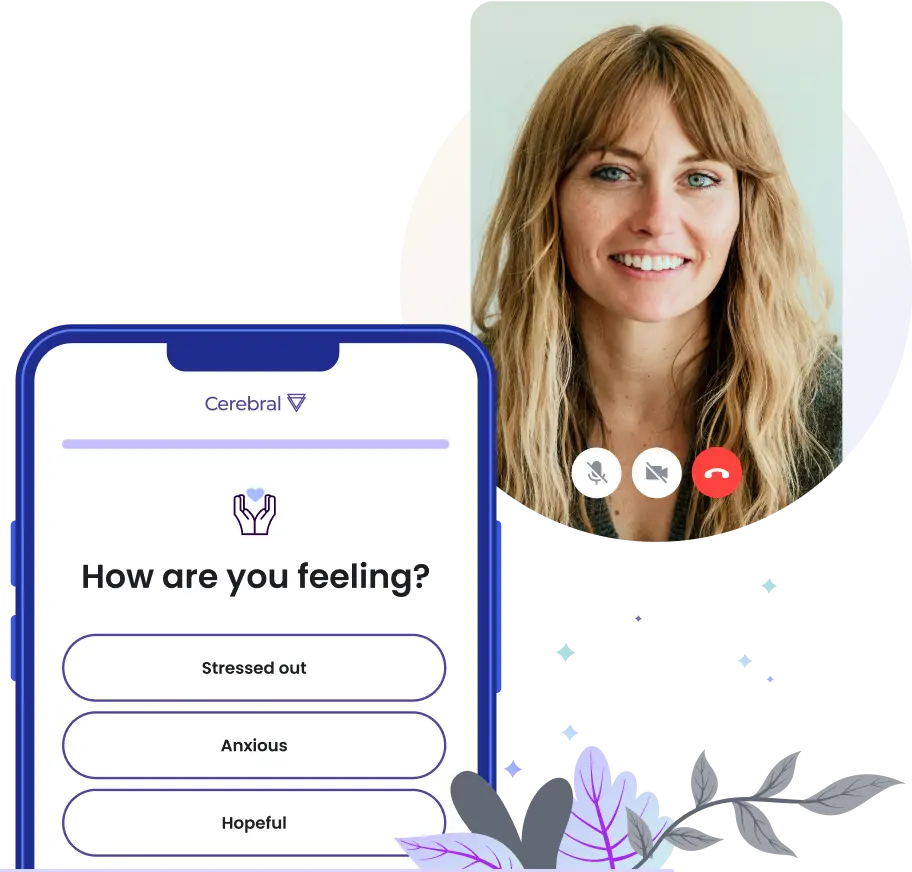Bipolar vs. BPD: How To Tell The Difference

Understanding the differences between bipolar disorder and borderline personality disorder (BPD) can be challenging. Both conditions affect mood and behavior but have distinct characteristics and may respond to different treatment approaches.
In this informative guide, we'll explore what sets these two disorders apart, how they're similar, how they're diagnosed, and how you can get affordable, convenient mental healthcare.
What is bipolar disorder?
Bipolar disorder is a mental health condition characterized by extreme mood changes that include emotional highs (mania or hypomania) and lows (depression). These mood changes can affect sleep, energy, behavior, and the ability to think clearly, ultimately impacting daily life overall.
Types of bipolar disorder
There are 3 types of bipolar disorder that are differentiated by the nature and intensity of the mood episodes experienced, including the duration and pattern of manic, hypomanic, and depressive episodes. Those types of bipolar disorder are:
- Bipolar I disorder: This type involves severe mood episodes from mania to depression. Mania is a state of heightened mood, activity, or energy levels that last for at least 7 days or requires hospitalization.
- Bipolar II disorder: In this type, individuals experience depressive episodes and hypomanic episodes, which are less severe than full-blown manic episodes.
- Cyclothymic disorder: This is a milder form of bipolar disorder, with periods of hypomanic symptoms and depressive symptoms lasting for at least 2 years in adults (1 year in children and adolescents), but the symptoms do not meet the diagnostic criteria for a hypomanic episode and a depressive episode.
It's important to consult with a mental health professional if you or someone you know is experiencing symptoms that align with any of these types of bipolar disorder.
Symptoms of bipolar disorder
Symptoms can vary widely between individuals and can range from mild to severe.
Symptoms of mania include:
- Increased energy, activity, and restlessness
- Excessively euphoric mood
- Extreme irritability
- Rapid speech and racing thoughts
- Poor concentration
- Little need for sleep
- Unrealistic beliefs in one's abilities and powers
- Impulsiveness and risk-taking behaviors
Symptoms of depression include:
- Lasting sad, anxious, or empty mood
- Feelings of hopelessness or pessimism
- Feelings of guilt, worthlessness, or helplessness
- Loss of interest in activities once enjoyed
- Decreased energy or fatigue
- Difficulty concentrating, remembering, or making decisions
- Restlessness or irritability
- Sleeping too much or inability to sleep
- Appetite or weight changes
- Chronic pain or other persistent physical symptoms not caused by illness or injury
- Thoughts of suicide or death, or suicide attempts
Understanding these symptoms can help in identifying the condition early and seeking timely intervention.
Bipolar disorder treatment options
When it comes to managing bipolar disorder, a multi-faceted approach is often recommended. Treatment typically involves a combination of medications and psychotherapy, tailored to meet the specific needs of the individual.
- Medication: Common medications include mood stabilizers and antipsychotic medications.
- Therapy: Psychotherapy, such as cognitive behavioral therapy (CBT), can help manage symptoms by addressing negative thought patterns and behaviors. Seeing a therapist who specializes in interpersonal and social rhythm therapy (IPSRT), family therapy, or psychoeducation can also be beneficial for those affected by bipolar disorder and their loved ones.
Early diagnosis and adherence to a treatment plan can help stabilize mood and reduce the risk of relapse. Each person's experience with bipolar disorder is unique, and understanding the various treatment options can empower individuals to manage their mental health.

What is borderline personality disorder?
Borderline personality disorder (BPD) is a mental health disorder characterized by intense emotional instability, impulsive behaviors, and difficulties in maintaining interpersonal relationships.
This instability often disrupts family, work, and/or daily life, long-term planning, and the individual’s sense of self-identity.
Symptoms of BPD
BPD symptoms often manifest in ways that significantly impact an individual’s daily life and relationships. The signs include:
- Intense fear of abandonment, even going to extreme measures to avoid real or imagined separation or rejection.
- A pattern of unstable, intense relationships, such as idealizing someone one moment and then suddenly believing the person doesn't care enough or is cruel.
- Rapid changes in self-identity and self-image that include shifting goals and values, and seeing yourself as bad or as if you don't exist at all.
- Periods of stress-related paranoia and loss of contact with reality, lasting from a few minutes to a few hours.
- Impulsive and risky behavior, such as gambling, reckless driving, unsafe sex, spending sprees, binge eating, or drug abuse.
- Suicidal threats or behavior or self-injury, often in response to fear of separation or rejection.
- Wide mood swings lasting from a few hours to a few days, which can include intense happiness, irritability, shame, or anxiety.
- Ongoing feelings of emptiness, being emotionally numb, disconnected, or incomplete, leading to constant seeking of external validation or stimulation to fill this void.
- Inappropriate, intense anger, such as frequently losing your temper, being bitter, or having physical fights.
Seek professional help if you or someone you know is exhibiting signs of this condition. BPD requires careful diagnosis and tailored treatment plans.
Treatment options for BPD
Treating BPD involves a comprehensive and individualized approach aimed at addressing the diverse range of symptoms associated with the condition. Given the complexity and intensity of BPD, a combination of therapeutic methods is often necessary to achieve the best outcomes.
- Medication: Antidepressants, antipsychotics, or mood stabilizers may help with symptoms of BPD, but they generally aren’t used as the primary way to treat the condition.
- Therapy: Dialectical behavior therapy (DBT), cognitive behavioral therapy (CBT), schema-focused therapy, and mentalization-based therapy are effective forms of psychotherapy for BPD. DBT, in particular, is designed specifically for people with BPD and focuses on teaching skills to cope with stress, regulate emotions, and improve relationships with others.
Understanding the available treatment options can provide those affected with tools and support to manage their symptoms and lead more balanced lives.
Key differences between bipolar and BPD
While bipolar disorder and BPD share some overlapping symptoms, they are distinct in several ways.
When impulsive behaviors occur
In bipolar disorder, impulsive behaviors usually occur during manic or hypomanic episodes.
In contrast, individuals with BPD may exhibit impulsive behavior more consistently, at any time, and the behaviors are often triggered by fear of abandonment or rejection.
Sleep
People with bipolar disorder often experience changes in sleep patterns, with manic episodes usually involving a decreased need for sleep, while depressive episodes may involve excessive sleeping.
Those with BPD may also have sleep disturbances, but these are usually related to stress or emotional turmoil rather than distinct episodes.
Length of episodes
Bipolar disorder is characterized by distinct periods of mania or hypomania and depression that can last for days, weeks, or even months.
BPD mood swings are often shorter, more rapid, and can fluctuate within a single day.
Relationships
Those with bipolar disorder may experience relationship difficulties during mood episodes but not necessarily at other times.
Conversely, people with BPD often have intense and unstable relationships that are marked by idealization and devaluation.
Triggers
Bipolar mood shifts often don’t have a clear trigger and can occur spontaneously.
For individuals with BPD, mood swings are usually triggered by interpersonal stressors and perceived abandonment.
Self-harm
While self-harming behaviors can also occur in bipolar disorder, it's typically linked to severe depressive episodes.
These behaviors, however, are more common in BPD as a coping mechanism for emotional pain or as a way to express anger or frustration.
Self-esteem
Self-esteem can fluctuate with bipolar mood episodes, often inflated during manic phases and severely diminished during depressive phases.
In contrast, Individuals with BPD often struggle with self-esteem, as it’s typically low and unstable due to it being heavily influenced by perceived rejection or failure.

Diagnosing borderline personality vs. bipolar
Mental health professionals use a combination of clinical interviews, patient history, and symptom assessment to differentiate between BPD and bipolar disorder.
- Clinical interviews: These involve detailed conversations with the patient to understand their symptoms, duration, and impact on daily life.
- Patient history: Understanding the patient’s personal and family mental health history helps in identifying patterns and potential genetic factors.
- Symptom assessment: Standardized assessment tools and questionnaires can aid in evaluating the specific symptoms and their severity.
Collaboration with mental healthcare providers will help you get a comprehensive assessment and personalized treatment options.
How Cerebral can help
Online mental health services like Cerebral can help in managing both bipolar disorder and BPD. Cerebral offers convenient access to therapy and medication management, making it easier for individuals to get the help they need without the barriers of traditional in-person visits.
Some of the many benefits include:
- Accessibility: Clients can access care from the comfort of their homes.
- Flexibility: Cerebral offers flexible scheduling, accommodating busy lifestyles and reducing the need for time off work or school.
- Continuity of care: Cerebral provides ongoing support and access to providers.
- Privacy: Virtual consultations offer a level of privacy that some patients may find more comfortable than visiting a physical location.
While bipolar disorder and borderline personality disorder share some similarities, they are distinct conditions that require different treatment approaches. Understanding these differences can help in getting a diagnosis and personalized treatment.
Cerebral can help you get just that. Sign up today.
Images by freepik, master1305, and drobotdean on Freepik.
The information in this blog is provided as a general educational resource only, and is not to be used or relied on for any diagnostic or treatment purpose. This information should not be used as a substitute for professional diagnosis and treatment and does not create any patient-physician relationship between you and Cerebral. Please consult your health care provider before making any health care decisions or to get guidance about a specific medical condition.

How to Support a Loved One with Bipolar Disorder

9 Common Triggers for Bipolar Episodes

Does Bipolar Disorder Get Worse With Age?

Call 911 if you’re having a
mental health emergency
Text Home to 741-741 if you're in emotional
distress and need immediate support
Call or text 988 Suicide &
Crisis Lifeline. Chat service
is available at 988lifeline.org.